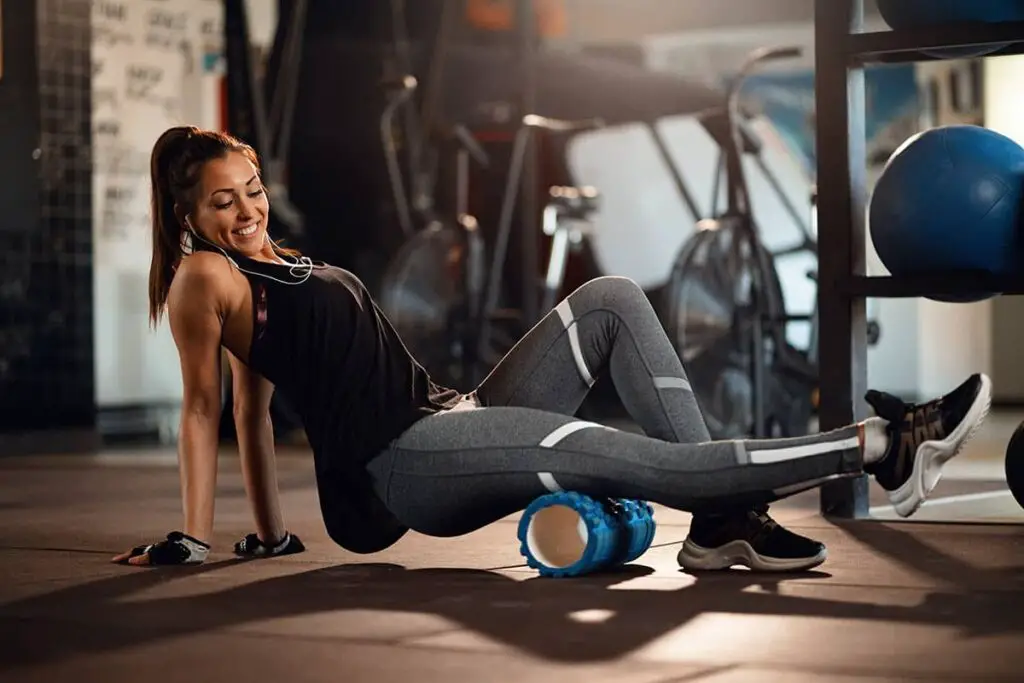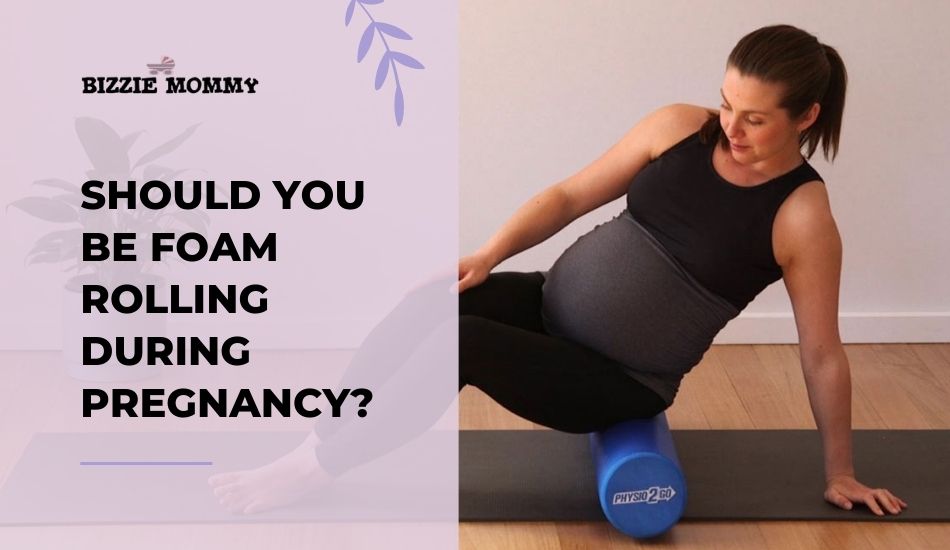Have you been using foam rolling as part of your daily routine? Now that you are pregnant, although your body is changing, things don’t necessarily have to change!
Foam rolling has several benefits during pregnancy. However, it is always a good idea to check with your doctor before you add something new to your fitness routine.
Is it Okay to Foam Roll While Pregnant?
The answer is yes, but you must be cautious.
If you’re pregnant, you can use a foam roller to get rid of soreness in the lower back and surrounding tissues. For instance, if you’re suffering from muscle soreness, you can use it to relieve pressure in the hips. It can also help you get rid of tightness in the glutes.
When you’re using a foam roll for treating cramps and limb soreness, you have to focus on one leg at a time. Slowly roll it forward and backward to enjoy maximum benefits.
Foam rolling is a type of self-myofascial release through which you can experience relief from pain by applying pressure to certain parts of your body. It helps with increasing circulation, which increases the oxygen supply to muscles.
However, since you’re pregnant, there are a few things to watch out for. You should avoid rolling on your back, especially in the last trimester, and you must not roll out your calves. This could result in early labor.
If you’re just starting out, it is important to follow some guidelines and find a comfortable position while rolling.
Benefits of Foam Rolling During Pregnancy
Using a foam roller while you are pregnant has many benefits, as shared below
- Muscle Relaxation
It can help reduce soreness and inflammation within muscles, which are quite common during pregnancy. When you place the roller underneath you, it exerts pressure on your body that helps increase circulation and transfers oxygen to your muscles.
- Getting Rid of Nagging Back Pain
This is one of the most troublesome complaints during pregnancy. As your body weight increases during the gestation cycle, the chances of developing lower back pain increase.
When you use a foam roller, it helps to ease back pain. Another great idea is to place a vibrating massage roller underneath your back to help get rid of the tension that tends to develop in the back.
Remember to be cautious while using a foam roller beneath your back because there is a risk of injury. Most people have recommended sticking to the lower back while using a roller during gestation. Having a trainer to help and supervise your foam rolling is also a great idea.
- It Helps You Unwind
Using a foam roller is relaxing for many during pregnancy. This is because it rids the muscles of tightness and soreness. After a full session of foam rolling, your body will be thanking you. Just be sure to perform this exercise slowly and, if you are just starting out, don’t aim for perfection.
- Increasing Mobility
Walking around and being active is a struggle when you are pregnant. When you use a foam roller, it will help substantially increase your mobility.
Your mood will be elevated and your mental stress, due to lethargy or fatigue, will decrease when you feel relaxed as a result of foam rolling. Stretching and increasing flexibility during gestation help get rid of lower backache, tight glutes, and fluid retention, and improves mobility.
- Decrease fluid retention
Fluid retention is one of the many common problems that you may experience while pregnant. It typically occurs in the mother’s feet, ankles, upper legs, fingers, hands, and forearms, and it can be pretty unpleasant and painful when she moves. This can be easily treated with foam rolling.
What Are the Contraindications of Foam Rolling?
There are certain contraindications of foam rolling, especially when you are an expectant mother.
Compared to an average female, the levels of the hormone relaxin are exceptionally elevated during pregnancy. As its name suggests, this hormone works to prepare you for labor by relaxing the pelvic joints. While this is good news for the moms-to-be, it may call for caution when foam rolling.
Unfortunately, relaxing can contribute to inflammation and pain by causing excessive movement in all body joints. If not handled properly, using the foam roller during pregnancy could aggravate pregnancy pains.
Experts usually recommend sticking to your lower body while you are trying to foam roll while pregnant, and ideally, you need to avoid the area near your bump.
Areas to Avoid Foam Rolling While Pregnant

The adductor (inner thighs) and inner points of the calf muscle must be avoided. The stimulation of both of these locations has been known to cause contractions, so it is best to avoid them when you use a foam roller.
There are several points in your feet that relate to initiating labor, so avoid rolling there as well. Light rolling can certainly help with circulation problems caused by excess weight on the femoral artery. If you are being careful, this can actually improve mobility.
Foam rollers can be used to target specific regions of the body, including your glutes, feet, calves, and hamstrings.
A Few Exercises to Try
Try the following exercises to experience the positive benefits of foam rolling:
For Glutes
Sit on the floor with both legs stretched out in front of you. Place the vibrating massage roller underneath your body in the gluteal area. Next, bend to one side and place the opposite ankle over the knee to concentrate on one side at a time. Apply pressure as you slowly roll back and forth.
For Hamstrings & Calves
Place the foam roller beneath your calf or hamstrings. With a longer roller, you may exercise both legs at once or focus on one leg at a time. Roll back and forth slowly while exerting downward pressure and pointing the toes forward.
For Feet
This can be done in either a sitting or standing position. Place the roller beneath your foot and apply pressure. For pregnant women, it is important to roll the foot back and forth slowly.
For Quads
Begin by lying face-down on a flat surface. Rest your forearms on the ground and place the core roller under your quadriceps. The other leg that isn’t being rolled should be comfortably positioned to the side.
Begin rolling your lower body up and down the core roller slowly. Stop focus on tender spots for at least 30 seconds for relief. Afterward, a total of four knee bends will stretch the muscle. Repeat with the opposite leg, opposite knee, and opposite ankle.
You can do this on both legs simultaneously if you want to apply less pressure. You can apply pressure on a single leg or use a longer roller for both legs.
For Thoracic Spine
Position your hands behind your head and the roller right behind your shoulder blades to support your neck. Slowly drop your head and shoulders as you exhale, extending over the roller.
Apply pressure and slowly roll back and forth to get relief from the pain. Keep the stretch to the upper back and avoid letting your bottom ribs rise up. Don’t forget to take deep, slow breaths while using the roller. It will help you relax.
Can Foam Rolling Cause Blood Clots?
Poor blood circulation is almost unavoidable as you age because the vascular endothelial function deteriorates. This deterioration results in stiffness in the arteries, commonly known as a condition called arteriosclerosis.
Arteriosclerosis is defined as a rise in the hardness and stiffness of the arterial wall and plaque formation in the arteries as a result of the stiff arteries. This is hazardous because it can induce blood clots which can be fatal.
Early prevention with massage rolling and other forms of stretching can significantly improve vascular endothelial function. Massage rolling can help delay, stop, or even reverse the stiffening of arteries in the early stages. Yoga and foam rolling are examples of flexibility exercises that will increase vascular endothelial function.
Because rollers force blood out of your muscles and replace it with new, oxygenated glycogen-carrying blood, they are particularly good for increasing blood circulation. Muscle regeneration needs oxygen and glycogen, and more oxygen means better circulation. That is why it’s so vital to breathe during foam rolling. As you roll, concentrate on taking deep breaths to increase the amount of oxygen in your blood and muscles.
Summary
With all the information that we have shared, we can assume that foam rolling during pregnancy has no obvious harmful impact. However, extra care is needed to use a roller during gestation. Also, there are some contraindications of using a roller during pregnancy, but under the guidance of a health care provider, you can use it without worry. Be sure to consult your gynecologist for any special care circumstances.

